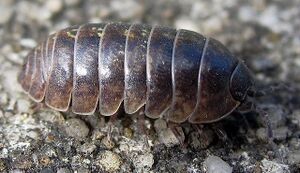Armadillidium vulgare
Armadillidium vulgare, also commonly referred to as the Common Pill bug, Sowbugs (even though this is an incorrect classification), Roly-Polies, Potato bugs and even Wood Lice. They are members of the Isopods, not to be confused with an insect[1]. They belong to the family Armadillidiidae and are found almost everywhere and are soil/ground dwelling isopods. These isopods can easily be spotted, as they roll into a ball to protect themselves. Pill bugs can reach densities of over 10,000 individuals per square meter which converts to 900 individuals per square foot [2]. There are 4,000 different species of Armadillidium vulgare and are none are considered dangerous—pill bugs do not bite, sting, or carry any diseases. They also do not lay their eggs indoors however, they may damage the roots of plants while feeding [3].
Taxonomy
Kingdom: Animalia
Subphylum: Crustacea
Class: Malacostraca
Order: Isopoda
Family: Armadillidiidae
Genus: Armadillidium
Species: vulgaris

Description
Pill bugs have a type of hard armor/shell, which is similar to that of an armadillo. This hard armor is used to protect the isopod from any danger. It is plate like and allows for a quick and full protection when they roll into a ball. These little guys are between 1/4 and 5/8 inches long and have seven pairs of legs and 2 pairs of antennae. They are most commonly found to be a light grey, but have been seen in many colors, including brown, black, yellow, and on rare occasions a deep red color [4]. They are special in the fact they exhibit extreme patience when they are threatened, spending hours inside of their ball until they feel it is safe to emerge [1]. In terms of speed they are considered slow movers, which is why they are so defensive with their outer shell. Their main source of food is decaying leaves and roots of some plants.
Habitat
Found all over the world, Pill bugs are quite lenient with this habitat choice. Usually found within the ground and leaf litter, they can find their homes below any type of forest or grass soil. They feed on roots while underground, which is the only time they are considered harmful. Flip over any type of rock or fallen tree and you'll more than likely find tens to hundreds of Pill bugs. They require a humid and dark habitat and are mainly nocturnal animals [5].
Ecosystem Importance
A study was conducted on the effects of the behavior of Pill bugs on decomposing dead plant material in a hardwood forest in Florida. The Pill bugs’ foraging had a positive impact on the ecosystem, shown by nutrients like nitrogen, phosphorous, and potassium being increased inside of the soil. Increased pH, and higher amounts of carbon eliminated from fallen leaves was also reported from the presence of these isopods [7].

Life Cycle
Eggs: Eggs are carried in a pouch by the mother on the underside of her body. The eggs can reach a diameter of 0.7 mm and after three to four weeks the eggs will start to hatch. Females may produce up to three broods every year and each brood is composed of 100-200 eggs.
Larva: The newborns continue living in the pouch on their mother for an additional one to two weeks and grow up to 2 mm in length before they are left on their own. While in the pouch, they feed on a fluid generated from the mother called marsupial fluid [6]. Once on their own the very next day the larva undergo their first molt. A few weeks later the second molt takes place, this allows for the seventh pair of legs to be created. Once the second molt take place, Pill bugs repeat the molting every two weeks for the next 18-20 weeks [6].
Adult: Once all molting is finished, the Pill bug is now an adult. This is when it will reach its maximum length and develop one pair of antennae and a pair of antennules which are used to help sense their surroundings and environment. As an adult they have compound eyes on both sides of their head and their body is usually made up of seven different segments with an abdomen. Seven pairs of legs are on an adult, one pair for each segment. You can tell the difference between the males and females once they reach adulthood. Females have a pouch on the underside, whereas males have copulatory organs in that same location. The expected lifespan for Armadillidium vulgare is anywhere from two to five years [6].
References
[1] (“Common Pillbug (Armadillidium vulgaris)” n.d.). . https://www.insectidentification.org/insect-description.php?identification=Common-Pillbug
[2] (Jan Frouza; Richard Lobinske; Jirí Kalcík; Arshad Ali (2008). . https://doi.org/10.1653/0015-4040(2008)91[328:EOTECA]2.0.CO;2
[3] (“How many species of pill bugs are there?” n.d.). . https://findanyanswer.com/how-many-species-of-pill-bugs-are-there
[4] (“Get Rid of Pill Bugs (Rollie Pollies) - Pill bug Pest Info” n.d.). . https://www.pestworld.org/pest-guide/occasional-invaders/pillbugs/
[5] (“pillbug - Armadillidium vulgare” n.d.). . https://entnemdept.ufl.edu/creatures/MISC/Armadillidium_vulgare.htm
[6] Capinera JL. 2001. Handbook of vegetable pests. Academic Press, San Diego. .
[7] Frouz J, Lobinske R, Kalcik J, Ali A. 2008. Effects of the exotic crustacean, Armadillidium vulgare (Isopoda), and other macrofauna on organic matter dynamics in soil microcosms in a hardwood forest in central Florida. Florida Entomological Society 91: 328-331. .